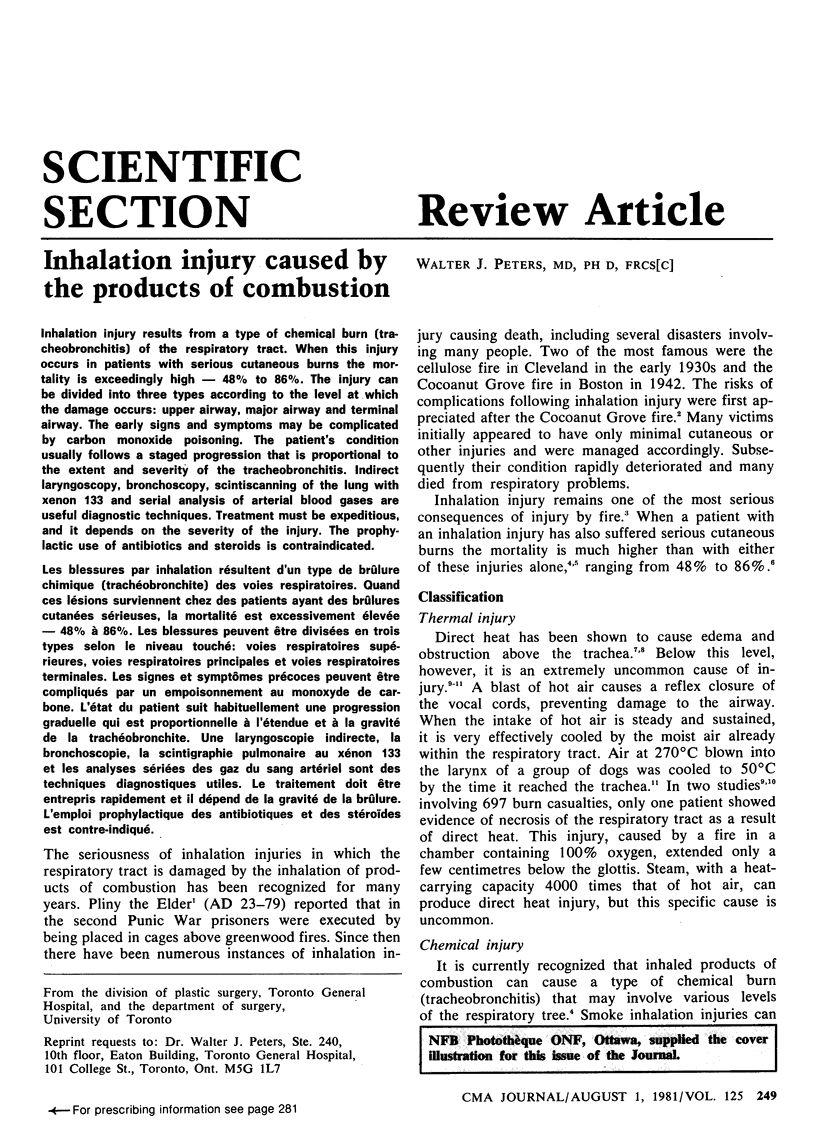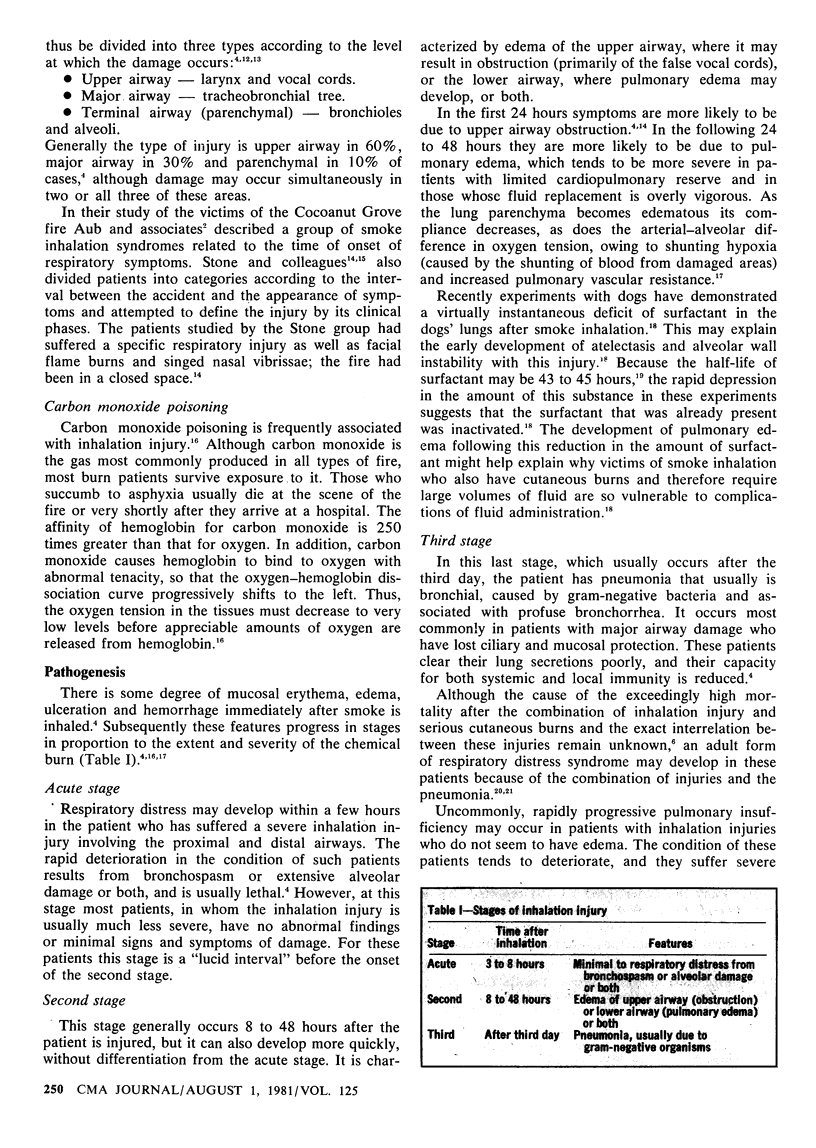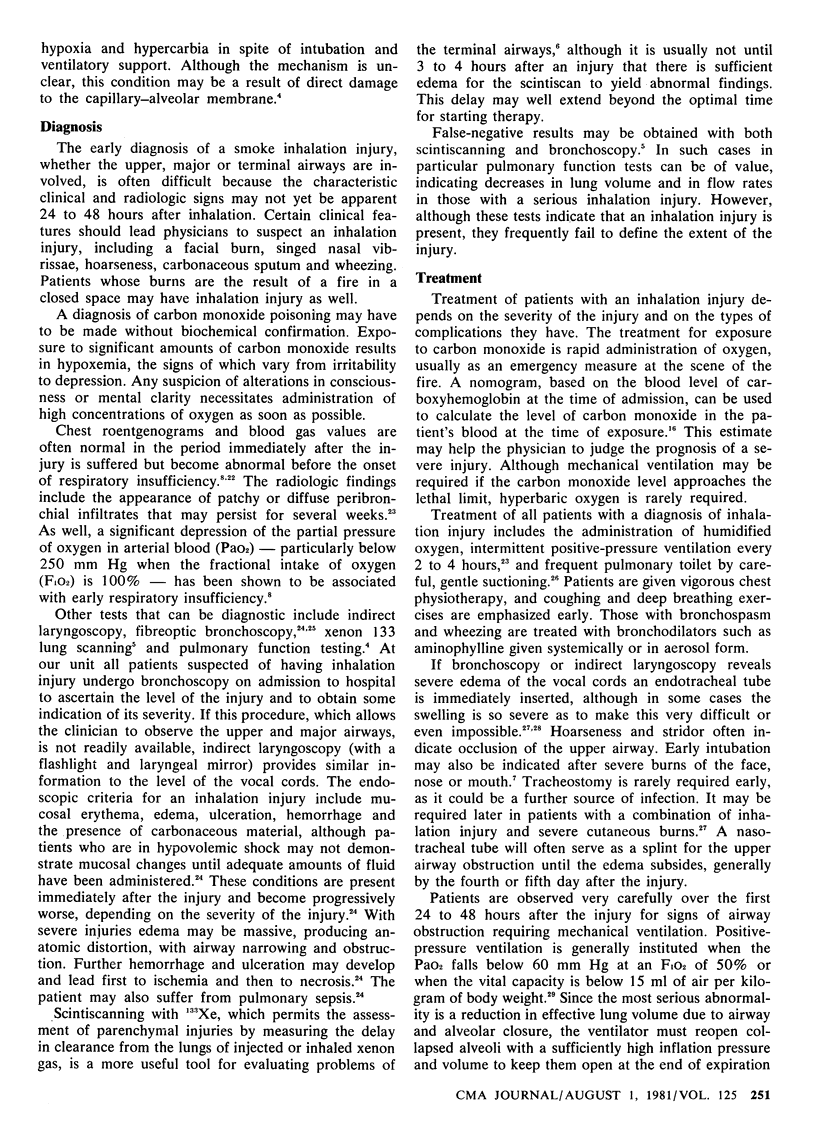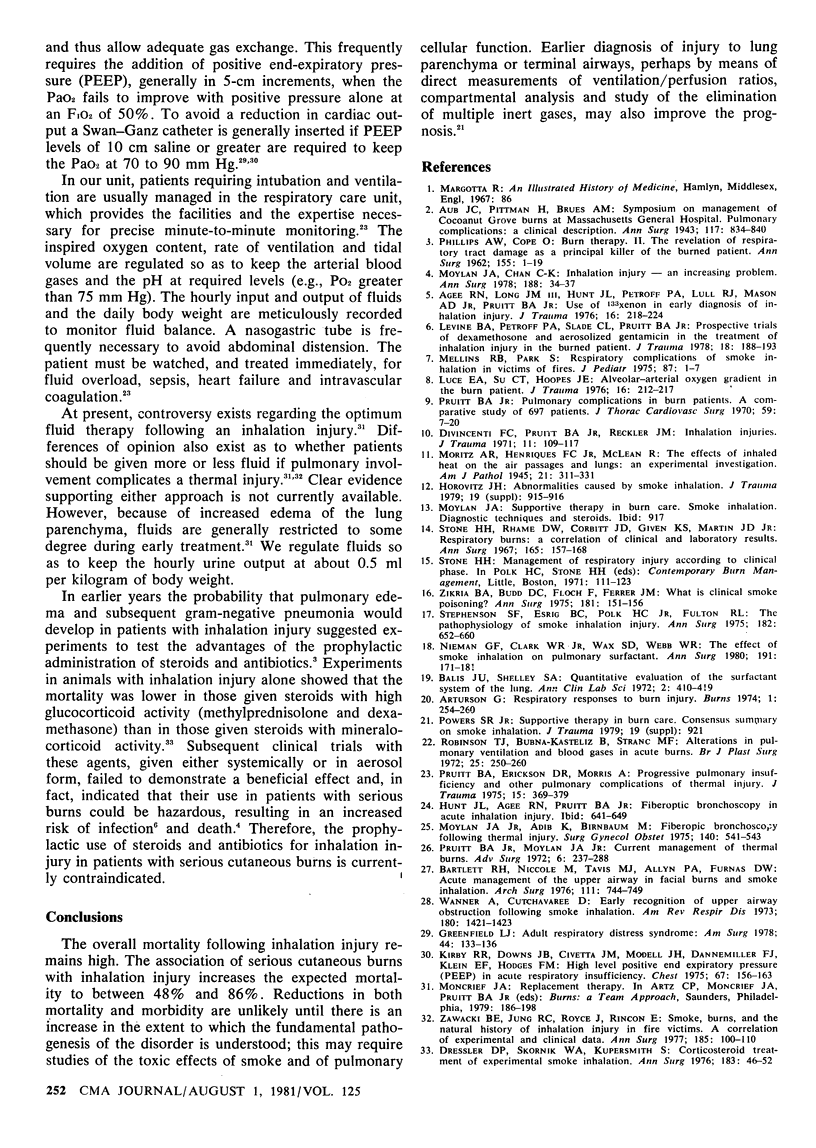Abstract
Inhalation injury results from a type of chemical burn (tracheobronchitis) of the respiratory tract. When this injury occurs in patients with serious cutaneous burns the mortality is exceedingly high- 48% to 86%. The injury can be divided into three types according to the level at which the damage occurs; upper airway, major airway and terminal airway. The early signs and symptoms may be complicated by carbon monoxide poisoning. The patient's condition usually follows a staged progression that is proportional to the extent and severity of the tracheobronchitis. Indirect laryngoscopy, bronchoscopy, scintiscanning of the lung with xenon 133 and serial analysis of arterial blood gases are useful diagnostic techniques. Treatment must be expeditious, and it depends on the severity of the injury. The prophylactic use of antibiotics and steroids is contraindicated.
Full text
PDF



Selected References
These references are in PubMed. This may not be the complete list of references from this article.
- Agee R. N., Long J. M., 3rd, Hunt J. L., Petroff P. A., Lull R. J., Mason A. D., Jr, Pruitt B. A., Jr Use of 133xenon in early diagnosis of inhalation injury. J Trauma. 1976 Mar;16(3):218–224. doi: 10.1097/00005373-197603000-00007. [DOI] [PubMed] [Google Scholar]
- Aub J. C., Pittman H., Brues A. M. THE PULMONARY COMPLICATIONS: A CLINICAL DESCRIPTION. Ann Surg. 1943 Jun;117(6):834–840. doi: 10.1097/00000658-194311760-00006. [DOI] [PMC free article] [PubMed] [Google Scholar]
- Balis J. U., Shelley S. A. Quantitative evaluation of the surfactant system of the lung. Ann Clin Lab Sci. 1972 Sep-Oct;2(5):410–419. [PubMed] [Google Scholar]
- Barlett R. H., Niccole M., Tavis M. J., Allyn P. A., Furnas D. W. Acute management of the upper airway in facial burns and smoke inhalation. Arch Surg. 1976 Jul;111(7):744–749. doi: 10.1001/archsurg.1976.01360250020003. [DOI] [PubMed] [Google Scholar]
- DiVincenti F. C., Pruitt B. A., Jr, Reckler J. M. Inhalation injuries. J Trauma. 1971 Feb;11(2):109–117. doi: 10.1097/00005373-197102000-00002. [DOI] [PubMed] [Google Scholar]
- Dressler D. P., Skornik W. A., Kupersmith S. Corticosteroid treatment of experimental smoke inhalation. Ann Surg. 1976 Jan;183(1):46–52. doi: 10.1097/00000658-197601000-00010. [DOI] [PMC free article] [PubMed] [Google Scholar]
- Horovitz J. H. Abnormalities caused by smoke inhalation. J Trauma. 1979 Nov;19(11 Suppl):915–916. [PubMed] [Google Scholar]
- Kirby R. R., Downs J. B., Civetta J. M., Modell J. H., Dannemiller F. J., Klein E. F., Hodges M. High level positive end expiratory pressure (PEEP) in acute respiratory insufficiency. Chest. 1975 Feb;67(2):156–163. doi: 10.1378/chest.67.2.156. [DOI] [PubMed] [Google Scholar]
- Levine B. A., Petroff P. A., Slade C. L., Pruitt B. A., Jr Prospective trials of dexamethasone and aerosolized gentamicin in the treatment of inhalation injury in the burned patient. J Trauma. 1978 Mar;18(3):188–193. doi: 10.1097/00005373-197803000-00007. [DOI] [PubMed] [Google Scholar]
- Luce E. A., Su C. T., Hoopes J. E. Alveolar-arterial oxygen gradient in the burn patient. J Trauma. 1976 Mar;16(3):212–217. doi: 10.1097/00005373-197603000-00006. [DOI] [PubMed] [Google Scholar]
- Mellins R. B. Respiratory complications of smoke inhalation in victims of fires. J Pediatr. 1975 Jul;87(1):1–7. doi: 10.1016/s0022-3476(75)80059-x. [DOI] [PubMed] [Google Scholar]
- Moritz A. R., Henriques F. C., McLean R. The Effects of Inhaled Heat on the Air Passages and Lungs: An Experimental Investigation. Am J Pathol. 1945 Mar;21(2):311–331. [PMC free article] [PubMed] [Google Scholar]
- Moylan J. A., Adib K., Birnbaum M. Fiberoptic bronchoscopy following thermal injury. Surg Gynecol Obstet. 1975 Apr;140(4):541–543. [PubMed] [Google Scholar]
- Moylan J. A., Chan C. K. Inhalation injury--an increasing problem. Ann Surg. 1978 Jul;188(1):34–37. doi: 10.1097/00000658-197807000-00005. [DOI] [PMC free article] [PubMed] [Google Scholar]
- Nieman G. F., Clark W. R., Jr, Wax S. D., Webb S. R. The effect of smoke inhalation on pulmonary surfactant. Ann Surg. 1980 Feb;191(2):171–181. doi: 10.1097/00000658-198002000-00008. [DOI] [PMC free article] [PubMed] [Google Scholar]
- PHILLIPS A. W., COPE O. Burn therapy. II. The revelation of respiratory tract damage as a principal killer of the burned patient. Ann Surg. 1962 Jan;155:1–19. doi: 10.1097/00000658-196201000-00001. [DOI] [PMC free article] [PubMed] [Google Scholar]
- Powers S. R., Jr Supportive therapy in burn care. Consensus summary on smoke inhalation. J Trauma. 1979 Nov;19(11 Suppl):921–921. [PubMed] [Google Scholar]
- Pruitt B. A., Jr, Erickson D. R., Morris A. Progressive pulmonary insufficiency and other pulmonary complications of thermal injury. J Trauma. 1975 May;15(5):369–379. [PubMed] [Google Scholar]
- Pruitt B. A., Jr, Flemma R. J., DiVincenti F. C., Foley F. D., Mason A. D., Jr, Young W. G., Jr Pulmonary complications in burn patients. A comparative study of 697 patients. J Thorac Cardiovasc Surg. 1970 Jan;59(1):7–20. [PubMed] [Google Scholar]
- Pruitt B. A., Jr, Moylan J. A., Jr Current management of thermal burns. Adv Surg. 1972;6:237–288. [PubMed] [Google Scholar]
- Stephenson S. F., Esrig B. C., Polk H. C., Jr, Fulton R. L. The pathophysiology of smoke inhalation injury. Ann Surg. 1975 Nov;182(5):652–660. doi: 10.1097/00000658-197511000-00020. [DOI] [PMC free article] [PubMed] [Google Scholar]
- Stone H. H., Rhame D. W., Corbitt J. D., Given K. S., Martin J. D., Jr Respiratory burns: a correlation of clinical and laboratory results. Ann Surg. 1967 Feb;165(2):157–168. doi: 10.1097/00000658-196702000-00001. [DOI] [PMC free article] [PubMed] [Google Scholar]
- Wanner A., Cutchavaree A. Early recognition of upper airway obstruction following smoke inhalation. Am Rev Respir Dis. 1973 Dec;108(6):1421–1423. doi: 10.1164/arrd.1973.108.6.1421. [DOI] [PubMed] [Google Scholar]
- Zawacki B. E., Jung R. C., Joyce J., Rincon E. Smoke, burns, and the natural history of inhalation injury in fire victims: a correlation of experimental and clinical data. Ann Surg. 1977 Jan;185(1):100–110. doi: 10.1097/00000658-197701000-00017. [DOI] [PMC free article] [PubMed] [Google Scholar]
- Zikria B. A., Budd D. C., Floch F., Ferrer J. M. What is clinical smoke poisoning? Ann Surg. 1975 Feb;181(2):151–156. doi: 10.1097/00000658-197502000-00004. [DOI] [PMC free article] [PubMed] [Google Scholar]


